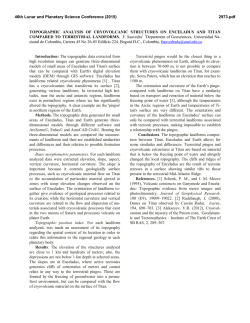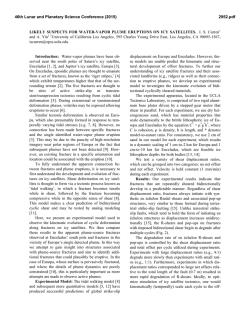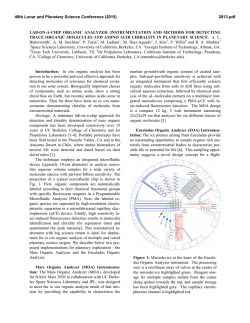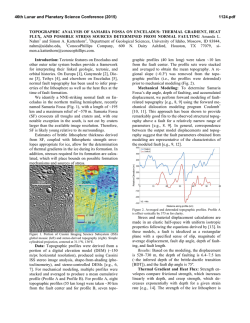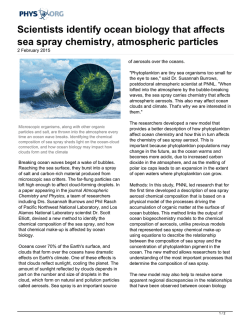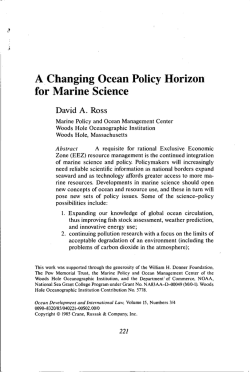
ENCELADUS LIFE FINDER: THE SEARCH FOR LIFE IN A
46th Lunar and Planetary Science Conference (2015) 1525.pdf ENCELADUS LIFE FINDER: THE SEARCH FOR LIFE IN A HABITABLE MOON. J.I. Lunine1, J.H. Waite2, F. Postberg3 L. Spilker4, and K. Clark5, 1Center for Radiophysics and Space Research, 402 Space Sciences, Cornell University, Ithaca NY 14853, [email protected], 2Southwest Research Institute, 6220 Culebra Road, San Antonio, TX 78228, [email protected], U. Stuttgart, Pfafferwaldring 29, D-70569, Stuttgart, [email protected],, 4Jet Propulsion Laboratory, M/S 230-205, 4800 Oak Grove Drive, Pasadena CA 91125, [email protected], 5JPL, 4800 Oak Grove Drive, Pasadena CA 91125, [email protected] Introduction: Is there life elsewhere in the solar system? This simple question is one of the motivators for the exploration of our solar system. Guided by the principle that we can most easily recognize life as we know it—life that requires liquid water—three extraterrestrial environments are commonly called out as candidates for hosting life today: the deep crust of Mars, the subsurface ocean of Europa, and an ocean within Enceladus. Of these three, Enceladus is particularly attractive because liquid water from its deep interior is actively erupting into space, making sampling of the interior straightforward. The Cassini Saturn Orbiter has demonstrated the feasibility of such sampling by making in situ measurements with relatively lowresolution mass spectrometers. Enceladus well known from previous missions: A thousand times smaller than Ganymede, Enceladus was known from Voyager data to be extremely bright; that and a dearth of craters on some parts of its surface suggested geologic activity and an endogenic source of the E-ring. Cassini discovered the presence and composition of a plume of material erupting from the south polar terrain (SPT) of Enceladus, over 100 narrow, distinct “geysers” or “jets” that feed it, and anomalous thermal emission along the fractures from which the geysers erupt. In particular, at high resolution, spatial coincidences between individual geysers and small-scale hot spots revealed the liquid reservoir supplying the eruptions to be not in the near-surface but deeper within the moon [1], putting on a firm foundation the principle that sampling the plume allows us to know the composition of the ocean. Sensitive gravity and topography measurements established the location and dimensions of that reservoir: ~ 35 km beneath the SPT ice shell and extending out to at least 50 degrees latitude, implying an interior ocean large enough to have been stable over geologic time [2]. The Cassini ion neutral mass spectrometer (INMS) discovered organic and nitrogen-bearing molecules in the plume vapor, and the Cosmic Dust Analyzer (CDA) detected salts in the plume icy grains, arguing strongly for ocean water being in contact with a rocky core [3], [4]. As much as Cassini has done, it cannot tell us whether in fact the ocean of Enceladus hosts an active biota today. And Cassini cannot provide detailed information on the ocean environment—pH, redox state, available free energy, and temperature—that allow for a quantitative assessment of the potential for life. Acquiring such knowledge represents the essential first step in characterizing the nature of the subsurface ocean and its biological potential. Enceladus Life Finder as the logical followon to Cassini: Enceladus Life Finder, or ELF, is a solarpowered Saturn orbiter designed to fly multiple times through the plume of Enceladus.The goals of the mission are derived directly from the most recent decadal survey: first, to determine primordial sources of organics and the sites of organic synthesis today, and second, to determine if there are modern habitats in the solar system beyond Earth where the conditions for life exist today—and if life exists there now. Enceladus is the ideal outer solar object to address these issues because of Cassini’s discovery of an organic- and saltrich water ocean, and the accessibility of its interior through the plume. The science goals are addressed through three science objectives: First, ELF measures abundances of a carefully selected set of neutral species, some of which were detected by Cassini, to ascertain whether the organics and volatiles coming from Enceladus have been thermally altered over time. Second, it determines the details of the interior marine environment—pH, oxidation state, available chemical energy, and temperature—that permit characterization of the life-carrying capacity of the interior. Third, ELF looks for indications that organics are the result of biological processes through three independent types of chemical measurements widely recognized as strongly diagnostic of life. ELF carries compositional instruments of far greater mass range, dynamic range, resolution and sensitivity than those on Cassini. The ELF payload consists of two time-of-flight instruments, the Mass Spectrometer for Planetary Exploration (MASPEX), and the Enceladus Icy Jet Analyzer (ENIJA), optimized to analyze respectively the gas and grains. Sample collection and processing are simple and robust; the high mass resolution and sensitivity available from the payload fully resolve composition (figure 1). Assessing habitability: The ability to use mass spectrometry to assess habitability of the interior oceanic environment has been given a “first test” with Cassini INMS and CDA [5,6], which points to the inte- 46th Lunar and Planetary Science Conference (2015) rior ocean being a solution of Na-Cl-CO3 with an alkaline pH of 11-12. Such a solution and pH could be produced via serpentinization of chondritic rock which in turn produces H2, a very favorable circumstance for life were it occurring today [7]. However, pH is only one indicator of the characteristics of an aqueous environment, and Cassini has not yet been able to determine the H2 abundance due to complications from titanium sputtering within the instrument aperture. ELF goes further to quantify the amount of H2, and to determine the oxidation state, the energy available from oxidation-reduction reactions, and the temperature at which reactions are occurring to put together a detailed picture of the nature and habitability of Enceladus’ aqueous environment. 1525.pdf ubiquity of amino acids and lipids in a broad range of such environments [8],[9]. Fig. 2: ELF’s three distinct tests for life provide 27 different possible outcomes; positive results for all three would strongly argue for life within Enceladus. Fig. 1: Mass resolution is crucial to removing ambiguities in species identification. Left: Cassini INMS data with resolution ~100 from the second Enceladus flyby; there is a species at mass 28 but it could be N, CO or C2H4. Right: increasing the mass resolution above 5000 resolves all three species (C2H4 would be off the figure to the right). Search for life: ELF conducts three tests for life. The first test looks for a characteristic “flat” distribution of amino acids [8], the second determines whether the carbon number distribution in fatty acids or isoprenoids is biased toward a particular rule (even, odd, or divisible by a small integer) [9], and the third measures carbon and hydrogen isotopic ratios, together with the abundance of methane relative to other alkanes, to assess whether the values fall in the range for biological processes. The tests are designed to minimize the ambiguity involved in life detection by adhering to the following principles: 1) They are distinct from each other—two are pattern related, one is isotopic. The two pattern tests involve completely different classes of organic compounds. 2) The tests seek properties of life that are inherent in its essential nature—the ability of life to overcome thermodynamic and kinetic barriers and use of repeating subunits to build molecules within a particular functional class. 3) The tests are as universal as possible for water-based life, given the expected A solar-powered, thermally conservative flight system (the fourth build of JPL’s core avionics product line), ELF conducts eight science plume fly-throughs over a 3-yr period, to pursue the implications of Cassini’s spectacular discoveries of active jetting from, and existence of an ocean within, Enceladus. The baseline science is completed in four flybys, leaving ample time for followup measurements to resolve ambiguities or pursue the implications of discoveries. Two additional contingency flybys beyond the eight add further robustnesss to the mission. ELF brings the most compelling question in all of space science within reach of NASA’s Discovery Program, providing an extraordinary opportunity to discover life elsewhere in the solar system in a low cost program. Fifty years after Voyager 2’s detailed imagery revealed the unusual nature of Enceladus’ surface, ELF will make measurements that may tell us whether we share the solar system with another biosphere. References: [1] Porco, C., diNino, D. and Nimmo, F. (2014). A.J. 148, 45. [2] Iess, L. et al. (2014), Science 344, 78. [3] Waite, J.H. (2009). Nature 460, 487. [4] Postberg, F. et. al. (2011). Nature 474, 620. [5] Postberg, F. et al. (2009) Nature 459, 1098. [6]. Glein, C., Waite, J.H. and Baross, J. (2015). Icarus, subm. [7] Russell, M.J. et. al. (2014). Astrobiology 14, 308. [8] Davila, A.F. and McKay, C.P. (2014). Astrobiology 14, 534. [9] Georgiou, C.D. and Deamer, D.W. (2014). Astrobiology 14, 541.
© Copyright 2026

